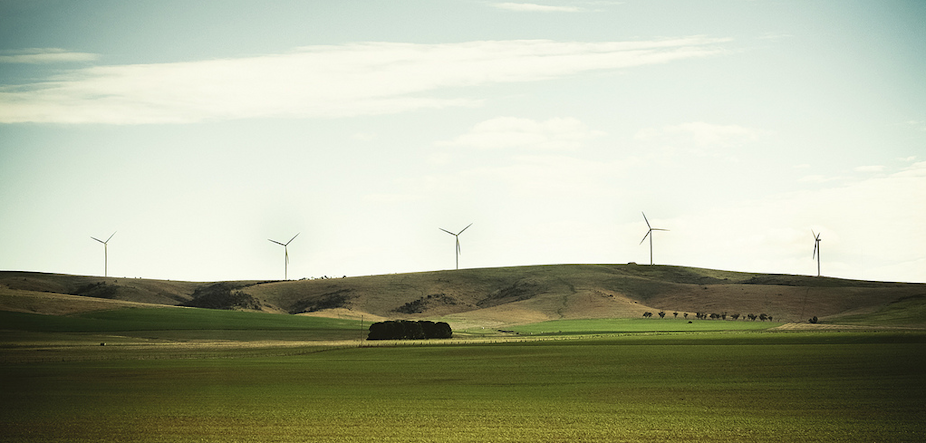Wind farms, like much new technology, have generated both strong community support and vocal opposition. Victoria has recently amended its planning laws and regulations to restrict locations for wind farms.
The amendments look set to entrench fossil fuel generation in the state, and make it harder for Victoria to move towards renewable energy.
Wind power: vital renewable, or health risk?
Wind power is a significant component of any effective response to climate change. Building more wind farms will help facilitate the structural change we’ll need to become a low-carbon economy.
Despite the global importance of wind farm development in reducing greenhouse gas emissions, in Victoria there has been ongoing debate about the adverse effects of wind farms.
Local communities have raised concerns about health and amenity impacts. A recent Federal Senate Inquiry recommended applying scientific measurements for sound and for shadow flicker to alleviate problems for wind farm neighbours. They said these may be preferable to prescribed distance setbacks as setbacks are arbitrary and may be too great or too small.
Moreover the Senate Committee found that there is no conclusive evidence that wind turbines have adverse effects on health.
Nonetheless, balancing the range of competing interests is complex, with many disputes around wind farms playing out in the legal system, including within major planning law frameworks.
How the laws manage competing interests
Planning decisions involve balancing different interests in, and uses of, land. The planning law system helps decision-makers undertake this balancing act by providing guidance, including long-term strategies.
Strategic planning lets development occur across the state in a coherent fashion. It enables development to conform with ideas of what we want our state to look like, how much electricity we want generated from renewable energy sources, where urban growth is to occur, where highways are to be built and so on.
In Victoria, the planning system is given effect under the Planning and Environment Act 1987. Under this Act, developers seeking to build wind farms must get a planning permit before proceeding with construction.
So what’s changed?
The first amendments by the Baillieu government in March 2011 returned the planning authority for all wind farm permits to the local government authorities. Formerly, wind farms with an installation size of more than 30MW were referred to the Minister for Planning for determination.
Wind farm proponents also had to identify all dwellings within 2km of the proposed installation.
The amendments introduced the more stringent 2010 New Zealand Standard for Wind Farm Noise. This set a noise limit of 40 decibel for dwellings in the vicinity of the proposed turbine.
Significantly, decision making on wind farm developments now must have regard to the “economic and environmental benefits to the broader community of renewable energy while also considering the need to minimise the effects of a proposal on the local community and environment”.
The second set of recent amendments extends considerably the areas to be excluded from wind farm development in Victoria. In effect, it creates wind farm “no go zones”.
“Wind energy facilities” are to be excluded from such areas due to the landscape and environmental values pertaining in those regions.
Creating no-go zones for wind
Previously, wind farms were excluded from national and state parks, coastal parks and Ramsar wetlands (comprising 43% of the Victorian coastline and 32 % of all the land). But now extensive new zones of exclusion are to operate.
Excluded zones now include the Yarra Valley and Dandenong Ranges, Mt Macdedon and Mc Harg Ranges. These include some of the best non-coastal wind resources in Victoria.
Also excluded are the Bellarine and Mornington Peninsulas, and all land within 5km of high water mark on the Great Ocean Road and the Bass Coast.
At a localised level, proposed wind farm developments now need to obtain the written consent of any owner of a dwelling within 2km of any turbine.
The amendments do not affect existing wind farms per se, although the new planning framework applies to any amendments necessary for already granted permits as of 15 March 2012.
Putting local above global concerns
At a strategic planning level, the amendments represent a significant change in direction. They give greater capacity to localised decision-making based on community concerns about wind farms, as opposed to addressing more globally-focused issues about facilitating renewable energy facilitation.
While the Baillieu government has stressed that such amendments provide “certainty”, the amendments effectively create a presumption against wind farm development over a large part of Victoria. There will be negative consequences for investments in wind farm facilities.
These changes add to existing barriers facing renewable energy promotion. There is a national target of 20% renewable energy generation by 2020, and a similar Victorian target. But there are barriers within renewable energy transmission infrastructure planning that militate against achieving these goals.
Electricity market rules for transmission planning pose particular problems for wind farms seeking connection to the grid. Moreover, the existing planning laws for energy networks and infrastructure development are oriented to a grid developed around major fossil fuel generation.
Treating wind as more dangerous than coal
In the past in Victoria, substantial rezoning has accommodated the expansion of fossil fuel power generation (see, for example, Australian Conservation Foundation v Latrobe CC (2004) 140 LGERA 100).
Moreover, in terms of minimum “setback” requirements it is notable that a dual gas/coal plant approved by the Victorian EPA earlier this year would be within 2km of residential areas.
The recent amendments, by creating many “no go zones” for wind farm development in Victoria will re-entrench existing patterns for energy transmission and generation and impact Victoria’s commitment to cutting GHG emissions.
This article was co-authored by Lisa Caripis, research assistant.

